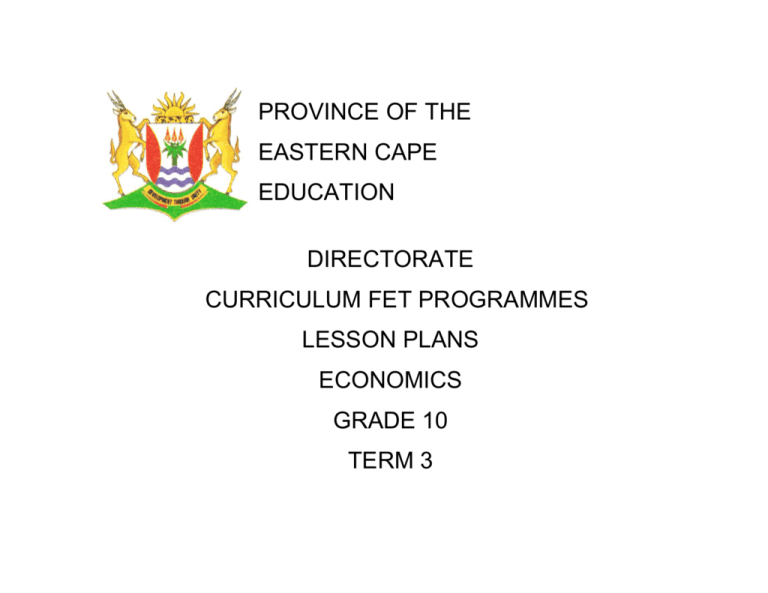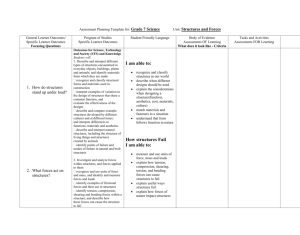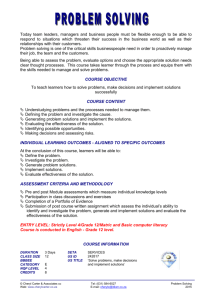Economics Lesson Plan
advertisement

PROVINCE OF THE EASTERN CAPE EDUCATION DIRECTORATE CURRICULUM FET PROGRAMMES LESSON PLANS ECONOMICS GRADE 10 TERM 3 FOREWORD The following Grade 10, 11 and 12 Lesson Plans were developed by Subject Advisors during May 2009. Teachers are requested to look at them, modify them where necessary to suit their contexts and resources. It must be remembered that Lesson Plans are working documents, and any comments to improve the lesson plans in this document will be appreciated. Teachers are urged to use this document with the following departmental policy documents: Subject Statement; LPG 2008; SAG 2008; Examination Guidelines 2009 and Provincial CASS Policy / Guidelines. Lesson planning is the duty of each and every individual teacher but it helps when teachers sometimes plan together as a group. This interaction not only helps teachers to understand how to apply the Learning Outcomes (LOs) and Assessment Standards (ASs) but also builds up the confidence of the teachers in handling the content using new Teacher strategies. It must please be noted that in order to help teachers who teach across grades and subjects, an attempt has been made to standardise lesson plan templates and thus the new template might not resemble the templates used in each subject during the NCS training. However, all the essential elements of a lesson plan have been retained. This change has been made to assist teachers and lighten their administrative load. Please note that these lesson plans are to be used only as a guide to complete the requirements of the Curriculum Statements and the work schedules and teachers are encouraged to develop their own learner activities to supplement and /or substitute some of the activities given here (depending on the school environment, number and type of Learner in your class, the resources available to your Learner, etc). Do not forget to build in the tasks for the Programme of Assessment into your Lesson Plans. Strengthen your efforts by supporting each other in clusters and share ideas. Good Luck with your endeavours to improve Teacher, Learning and Assessment. Page 2 of 8 Economics Term 3 Lesson Plans Grade 10 SUBJECT: ECONOMICS GRADE: 10 LESSON PLAN : 02 TERM 3 TIME: 8 HOURS TOPIC: History of early development of money since the 18tth century and now. CONTENT: History of money and banking INTEGRATION WITH HISTORY Learning Outcome 1: Macro-economics. The learner is able to demonstrate knowledge, critical understanding and application of the principles, processes and practices of the economy 10.1.1. Analyze Economics, describe its methods and relationships with other sciences, and investigate career opportunities. 10.1.2. Identify and explain the problem that all economies try to solve, and relate it to the basic processes of production, consumption and exchange, highlighting the promotion or violation of human rights and the environment 10.1.3. Discuss the participants, markets, and monetary and real flows in an open economy. Learning Outcome 2: Microeconomics Learning Outcome 3:Economic Pursuits: Learning Outcome 4: Contemporary Economic Issues: The learner is able to demonstrate knowledge, understanding and the appropriate skills in analyzing the dynamics of markets. The learner is able to demonstrate knowledge, understanding and critical awareness of the policies and practices underpinning the improvement of the standard of living. 10.3.1. Investigate and outline the stages of economic development in broad historical context, and relate them to evidence from Africa, where relevant. 10.3.2. Investigate and outline economic development in South Africa in historical context, highlighting indigenous knowledge systems and the impact of colonialism and imperialism. The learner is able to demonstrate knowledge, understanding and critical awareness, and apply a range of skills in dealing with contemporary economic issues. 10.2.1. Explain the market as a phenomenon and make use of graphs to illustrate the establishment of prices and quantities. 10.2.2. Describe production possibility curves (reflecting on efficiencies), and explain how they reconcile choice and scarcity. 10.2.3. Explain the effects, in terms of prices and quantities, of the public sector’s involvement and intervention in the market with the aid of graphs 10.1.4. Describe the reasons for business cycles and explain and illustrate their composition, mentioning the impact on the economically vulnerable. TEACHER ACTIVIES Page 3 of 8 LEARNER ACTIVITIES Economics Term 3 Lesson Plans 10.3.3. Investigate and outline the history of money and banking in South Africa. 10.4.1. Investigate and explain unemployment and debate the various approaches to solve it, taking cognizance of the economically marginalized. 10.4.2. Discuss labour relations and dispute resolution mechanisms, including labour rights and conventions, within the context of the South African labour market. X 10.4.3. Investigate and outline the reconstruction of the South African economy after 1994, as an effort to redress the inequalities of the past. 10.3.4..Describe the composition of the South African population and labour force, and explain the factors, such as HIV/AIDS, that impact on them. 10.4.4. Identify, engage in and communicate economic issues of the day, quantitative elements of Economics and other essentials RESOURCES ASSESSMENT Grade 10 X DATE COMPLETED In groups, learners are required to read a text on ‘how money has evolved’ and ask them to analyze, classify & link the information to different stages of economic development. Displays a chart with various forms & pictures of money used in South Africa during pre – and – post 1961 taken from the National Museum & Libraries. Explains the various stages as they are in the chart. Further explains the concept & types of money e.g. African; Indigenous ; Colonial; Imperial; S.A. barter system; medium of exchange; metallic money; precious metals; minting; legal tender; gold standard; notes; coins; deposit money. Facilitates & guides discussion on the: uses / functions of money; characteristics of money; security features of South African notes. Outlines the development of banks in S.A.; Types of banks; Uses & links. Consolidates by explaining the role played by money in Economic Growth using questions and answers. Homework: Enrichment/Expanded Opportunities: Teacher Reflections: They read as groups, analyze, classify and link information to different stages of economic development, tracing these according to timelines. Listen attentively and take notes Extract from the text, Timeline table Baseline Chart, Text book, Chalkboard, Newspapers. Educator assessment, Observation Class test. Discussion Text book, Chalkboard Homework Listen attentively and take notes Chalkboard, OHP, Data Projector Class work Listen attentively, answer questions Research Presentation SIGNATURES: ______________________________ TEACHER Page 4 of 8 ________________ DATE Economics Term 3 Lesson Plans _____________________________ HOD / SMT Grade 10 ____________ DATE SUBJECT: ECONOMICS GRADE: 10 LESSON PLAN : 03 TERM 3 TIME: 8 HOURS TOPIC: RSA Population CONTENT: Describing the South African population, the SA labour force, factors impacting on the population and labour force growth and composition (e.g. HIV/AIDS. INTEGRATION WITH GEOGRAPHY Learning Outcome 1: Macro-economics. The learner is able to demonstrate knowledge, critical understanding and application of the principles, processes and practices of the economy 10.1.1. Analyze Economics, describe its methods and relationships with other sciences, and investigate career opportunities. 10.1.2. Identify and explain the problem that all economies try to solve, and relate it to the basic processes of production, consumption and exchange, highlighting the promotion or violation of human rights and the environment 10.1.3. Discuss the participants, markets, and monetary and real flows in an open economy. Learning Outcome 2: Microeconomics Learning Outcome 3: Economic Pursuits: Learning Outcome 4: Contemporary Economic Issues: The learner is able to demonstrate knowledge, understanding and the appropriate skills in analysing the dynamics of markets. The learner is able to demonstrate knowledge, understanding and critical awareness of the policies and practices underpinning the improvement of the standard of living. 10.3.1. Investigate and outline the stages of economic development in broad historical context, and relate them to evidence from Africa, where relevant. 10.3.2. Investigate and outline economic development in South Africa in historical context, highlighting indigenous knowledge systems and the impact of colonialism and imperialism. The learner is able to demonstrate knowledge, understanding and critical awareness, and apply a range of skills in dealing with contemporary economic issues. 10.3.3. Investigate and outline the history of money and banking in South Africa. 10.4.3. Investigate and outline the reconstruction of the South African economy after 1994, as an effort to redress the inequalities of the past. 10.2.1. Explain the market as a phenomenon and make use of graphs to illustrate the establishment of prices and quantities. 10.2.2. Describe production possibility curves (reflecting on efficiencies), and explain how they reconcile choice and scarcity. 10.2.3. Explain the effects, in terms of prices and quantities, of the public sector’s involvement and intervention in the market with the aid of graphs 10.1.4. Describe the reasons for business cycles and explain and illustrate their composition, mentioning the impact on the economically vulnerable. TEACHER ACTIVIES Page 5 of 8 10.3.4..Describe the composition of the South African population and labour force, and explain the factors, such as HIV/AIDS, that impact on them. LEARNER ACTIVITIES Economics Term 3 Lesson Plans RESOURCES Grade 10 10.4.1. Investigate and explain unemployment and debate the various approaches to solve it, taking cognisance of the economically marginalized. 10.4.2. Discuss labour relations and dispute resolution mechanisms, including labour rights and conventions, within the context of the South African labour market. X 10.4.4. Identify, engage in and communicate economic issues of the day, quantitative elements of Economics and other essentials ASSESSMENT X DATE COMPLETED Learners are given population estimates from Stats S.A. that depict population groupings and gender at a given period. They are then requested to read and answer questions. The educator then discusses / explains the following : (a) Population growth – Demographic cycle (stages) – Migration and urbanization. Learners respond to questions from the given handouts and discussion around their responses ensues. Draw graphs from the statistic in the handouts given. - Textbooks Reports from Stats S.A. Internet (www.statssa.gov.za. Newspapers. Case study Learners listen attentively and respond to questions that are asked during the discussion / explanation. Participate in the discussion that emanate from the explanation of terms. (b) Labor force - Composition - Employment and unemployment - Labor migration (c) HIV / AIDS and its impact on the South African population and labor force using a variety of statistical extracts. Homework Enrichment/Expanded Opportunities: Teacher Reflections: SIGNATURES: ______________________________ TEACHER Page 6 of 8 ________________ DATE Economics Term 3 Lesson Plans _____________________________ HOD / SMT Grade 10 ____________ DATE SUBJECT: Economics GRADE: 10 TOPIC: Unemployment in RSA LESSON PLAN :04 TERM 3 TIME: 12 HOURS CONTENT: The nature of unemployment approaches to solving unemployment, and the ability of marginalized groups to participate in the economy. INTEGRATION WITH ENGLISH Learning Outcome 1: Macro-economics. The learner is able to demonstrate knowledge, critical understanding and application of the principles, processes and practices of the economy 10.1.1. Analyze Economics, describe its methods and relationships with other sciences, and investigate career opportunities. 10.1.2. Identify and explain the problem that all economies try to solve, and relate it to the basic processes of production, consumption and exchange, highlighting the promotion or violation of human rights and the environment 10.1.3. Discuss the participants, markets, and monetary and real flows in an open economy. Learning Outcome 2: Microeconomics Learning Outcome 3: Economic Pursuits: Learning Outcome 4: Contemporary Economic Issues: The learner is able to demonstrate knowledge, understanding and the appropriate skills in analyzing the dynamics of markets. The learner is able to demonstrate knowledge, understanding and critical awareness of the policies and practices underpinning the improvement of the standard of living. 10.3.1. Investigate and outline the stages of economic development in broad historical context, and relate them to evidence from Africa, where relevant. 10.3.2. Investigate and outline economic development in South Africa in historical context, highlighting indigenous knowledge systems and the impact of colonialism and imperialism. The learner is able to demonstrate knowledge, understanding and critical awareness, and apply a range of skills in dealing with contemporary economic issues. 10.3.3. Investigate and outline the history of money and banking in South Africa. 10.4.3. Investigate and outline the reconstruction of the South African economy after 1994, as an effort to redress the inequalities of the past. 10.3.4..Describe the composition of the South African population and labour force, and explain the factors, such as HIV/AIDS, that impact on them. 10.4.4. Identify, engage in and communicate economic issues of the day, quantitative elements of Economics and other essentials 10.2.1. Explain the market as a phenomenon and make use of graphs to illustrate the establishment of prices and quantities. 10.2.2. Describe production possibility curves (reflecting on efficiencies), and explain how they reconcile choice and scarcity. 10.2.3. Explain the effects, in terms of prices and quantities, of the public sector’s involvement and intervention in the market with the aid of graphs 10.1.4. Describe the reasons for business cycles and explain and illustrate their composition, mentioning the impact on the economically vulnerable. 10.4.1. Investigate and explain unemployment and debate the various approaches to solve it, taking cognizance of the economically marginalized. 10.4.2. Discuss labour relations and dispute resolution mechanisms, including labour rights and conventions, within the context of the South African labour market. TEACHER ACTIVIES LEARNER ACTIVITIES RESOURCES ASSESSMENT Teacher facilitates a fact-finding exercise and brief sharing of information session on where to obtain the following Participate in the brainstorm session and; fill/complete the application forms as per instruction. Textbooks Class work Libraries Homework Page 7 of 8 Economics Term 3 Lesson Plans Grade 10 X X DATE COMPLETED application forms: UIF: Magazines Practicals Unemployment insurance Pension Child support grant Maintenance grant ID document Tax returns. Also directs learners to fill one or more of the Application forms. Directs learners to provide an overview of Unemployment and explains unemployment: Short test Research and presentation Peers Controlled test Deliberate on the topic/investigate and report to the class (participate in brief discussion in class). Textbooks Also listen, ask questions and take notes Nature Approaches to solving unemployment Ask learners to identify a marginalized person in their community who does not have access to financial assistance and find out how that person could gain access to financial benefits. Summarizes/short explanation on how the marginalized can participate in the Economy Administers a controlled test Homework: Enrichment/Expanded Opportunities: Teacher Reflections: Report back to class or peers. Textbooks Listen, take notes and ask questions Textbooks Write a controlled test SIGNATURES: ______________________________ TEACHER Page 8 of 8 ________________ DATE Economics Term 3 Lesson Plans _____________________________ HOD / SMT Grade 10 ____________ DATE







